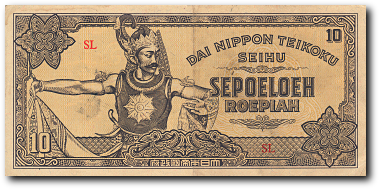
The Dutch East Indies, or Netherlands East Indies, was the Dutch colony that soon after the war gained independence and is now known as Indonesia.
In 1942, Japan issued paper banknotes for Een (1), Vijf (5), Tien (10) cents and Half (½), Een (1), Vijf (5), Tien (10) Guldens. Dutch East Indies notes are distinguished by the code letter ‘S’ which denoted Sumatra. The notes bear the Dutch text ‘De Japansche Regeering Betaalt Aan Toonder’ which translates to ‘The Japanese Government Promise To Pay The Bearer On Demand’.
In 1944, Japan issued 100 and 1,000 Roepiah. These notes bear ‘Pemerintah Dai Nippon’ which translates to ‘Japanese Government’. Notes for ½, 1, 5, 10 and 100 Roepiah were also released in 1944 with ‘Dai Nippon Teikoku Seiku’ which translates to Imperial Japanese Government.

Dutch East Indies notes were produced in the following denominations: Een (1) Cent, Vijf (5) Cent, Tien (10) Cent, Half Gulden, Een (1) Gulden, Vijf (5) Gulden, Tien (10) Gulden, Setengah (½) Roepiah, Satoe (1) Roepiah, Lima (5) Roepiah, Sepoeloeh (10) Roepiah, Seratoes (100) Roepiah, Seriboe (1000) Roepiah.
Photo: Japanese Marines, listed as war criminals, loading cases of Japanese Invasion Money onto a truck. Borneo, October 1945.


